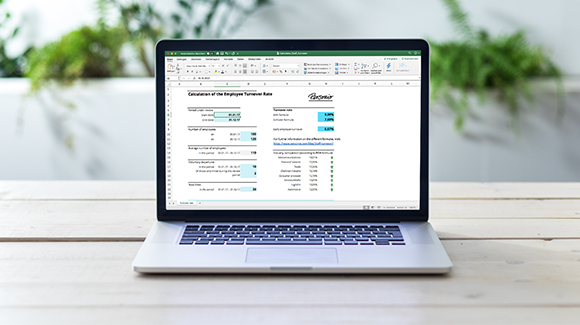
Turn data into strategic insights.
Enable proactive decision-making with People Analytics.
Create reports in secondsIs Employee Turnover What You Think It Is?

Your staff turnover rate is an important indicator of success for just about any company. Together, alongside other factors, knowing your turnover rate can give you an insightful gaze into personnel movement within your organisation.
Keep in mind: A high rate of staff turnover often signals a need for action on the part of HR, and in terms of figuring out a way to optimise employee retention (click here for more on that topic).
Download our staff turnover calculator today to gain rapid insights into your turnover rates.
What Is Staff Turnover?
Staff turnover, often referred to in terms of a ‘turnover rate,’ specifies the level of personnel movement in a company. This can include both employees leaving the company as well as internal and employee-initiated transfers. For this reason, the perspective from which you calculate employee turnover is critical.
Calculating the turnover rate for individual departments is just as important as considering the company as a whole. For example, a high employee turnover rate in a single large department may be a sign of poor management. If a company’s turnover, natural fluctuation aside, is above average, the cause may be the behaviour of the company toward its employees.
Download this helpful template to help you calculate your own turnover rate today
Are There Different Forms of Staff Turnover?
Experts commonly distinguish between the following types of turnover:
Natural turnover (retirement, death, etc.)
Internal turnover (transfers)
External turnover (dismissals and resignations)
Early staff turnover is a topic in and of itself. You should always consider this particular subcategory of external turnover separately in your turnover calculation. The higher the turnover rate is, the more likely it is that there are issues in either your employee selection or integration process.
How Do You Determine Staff Turnover?
Once you know what your company’s turnover rate is, you can take action to improve it. Therefore, your employee turnover rate is an indispensable indicator when it comes to successful HR controlling.
Staff turnover is an indispensable controlling indicator for HR.
You can use various formulas for your employee turnover calculation. Two of the most commonly used are the BDA and Schlüter formulas (Try downloading this helpful template for your staff turnover calculation).
These two formulas use different reference values and will often reveal differing results. That in mind, if you do plan to calculate and compare your turnover rate over the long term, be sure to always use the same formula. This is the only way that you will be able to obtain reliable comparison values.
Staff Turnover Formulas: Templates & Explanations
Let’s dive into calculating staff turnover! First, though, we need to work within a period of time. While you can track staff turnover as often as you like, for our purposes today let’s calculate staff turnover over the course of a year.
That said, you can assess staff turnover on a monthly, quarterly, or annual basis. It really depends on how fast your company is growing, and which time period would give you the most qualitative results and action items.
All that in mind, let’s operate with these numbers in mind:
Employee headcount at beginning of period: 120
Average headcount throughout the period: 119
Voluntary departures during the period: 14
New hires during the period: 12
Take Our Staff Turnover Calculator With You

Our free staff turnover calculator comes in the form of an Excel sheet, so you can take it with you on your way and keep it secure on your own database. Click the button below to download it today.
Download the Excel CalculatorStaff Turnover Calculation: BDA Formula
The BDA formula is one of the most commonly used methods for calculating staff turnover. It uses the classic method of comparing the number of employees leaving with the average number of employees overall.
Turnover Rate = Voluntary Departures ÷ Average Headcount x 100
Using the numbers above, let’s put this into practice:
Turnover Rate = 14 ÷ 119 x 100 Turnover Rate = 11.76%
There you have it!
Staff Turnover Calculation: Schlüter Formula
On the other side of things, the popular Schlüter formula does not use average headcount in its calculations. Instead, it considers the number of employees at the beginning of the period along with new hires.
In doing so, it considers headcount as a key date value, while employees leaving is represented as a time period value
Turnover Rate = Departures ÷ (Starting Headcount + New Hires) x 100
So, how does this look in practice? Let’s take a look…
Turnover Rate = 14 ÷ (120 + 12) x 100 Turnover Rate = 10.61%
And, that’s the Schlüter formula!
Staff Turnover & Personnel Costs
The loss of employees always comes at a cost. The extent of these costs depends primarily on the required qualification level of the employee. The costs involved in recruitment, employee training, and loss of expertise are directly related to the requirement profile for the position.
If a high achiever leaves the company, the costs involved will amount to approximately 120 percent of their annual salary.
30% is accounted for by the under-performance of the departing employee during and after their decision to leave the company, any leave of absence they take, overtime by colleagues, temporary personnel, etc.
30% of recruitment advertising costs
10% other selection and recruitment costs
50% of introductory training costs over the first year
2% of administrative costs
If you keep a constant eye on your turnover rate, you will be able to take targeted action to improve it or preemptively make sure that it stays as low as possible.
Is Your Staff Turnover High or Low On Average?
Your turnover rate is a key indicator that can give you important long-term information on employee turnover. In industry-specific comparisons, it can tell you whether your company’s staff turnover is within the normal range. As shown in the examples below, the turnover rate within individual industries can vary considerably.
Employee Turnover Rates By Industry:
Telecommunications 18.01%
Financial services, banking 17.69%
Trade, wholesale 17.35%
Chemicals 16.14%
Consumer products 15.18%
Services, media 13.83%
Logistics 13.08%
Automotive 12%
According to this list, staff turnover in telecommunications is relatively high compared to the automotive sector. This is caused by industry-specific influencing factors, such as call centres, which are characteristic of the telecommunications industry. These have a negative effect on the general turnover rate. Considering call centre staff turnover in isolation significantly changes the results and thus the conclusions that can be drawn from this indicator.
If you are having trouble collecting the necessary data to determine employee turnover, you should invest in your data quality as a matter of urgency. Modern HR cannot function without data.
Since each industry is subject to its own unique influencing factors, an industry-specific comparison of turnover rates or even separate calculations for individual service sectors within an industry makes a lot of sense. Only companies operating under similar conditions can provide you with meaningful information.
Employee requirement profiles are similar in terms of qualifications.
All companies in the industry face similar labour market conditions.
Companies share similar corporate structures (call centres, logistics centres, research laboratories).
Reporting On Turnover (& More) With Personio

Personio allows you to automatically report on staff turnover broken down by department, month, and reason for leaving. Learn more about our reports function today.
HR Reports with PersonioWhat Causes High Turnover Rates?
The causes of employee turnover have been intensively researched for a long time. Nevertheless, all of the current theories have some shortcomings. There is, however, a discernible trend to the overriding motivations that cause employees to leave a company:
Affective reasons such as corporate image.
Rational reasons such as a salary that is too low, an excessive workload, or a lack of opportunities for further development.
Employee dissatisfaction due to bad management or neglected HR work.
The employee’s personal career plans.
Shock-induced motivations such as the refusal of an expected promotion.
This is just a selection of the possible reasons for a company’s high employee turnover. However, if you know your turnover rate and you know the causes, you have a very good chance of being able to reduce staff turnover by taking targeted action.
